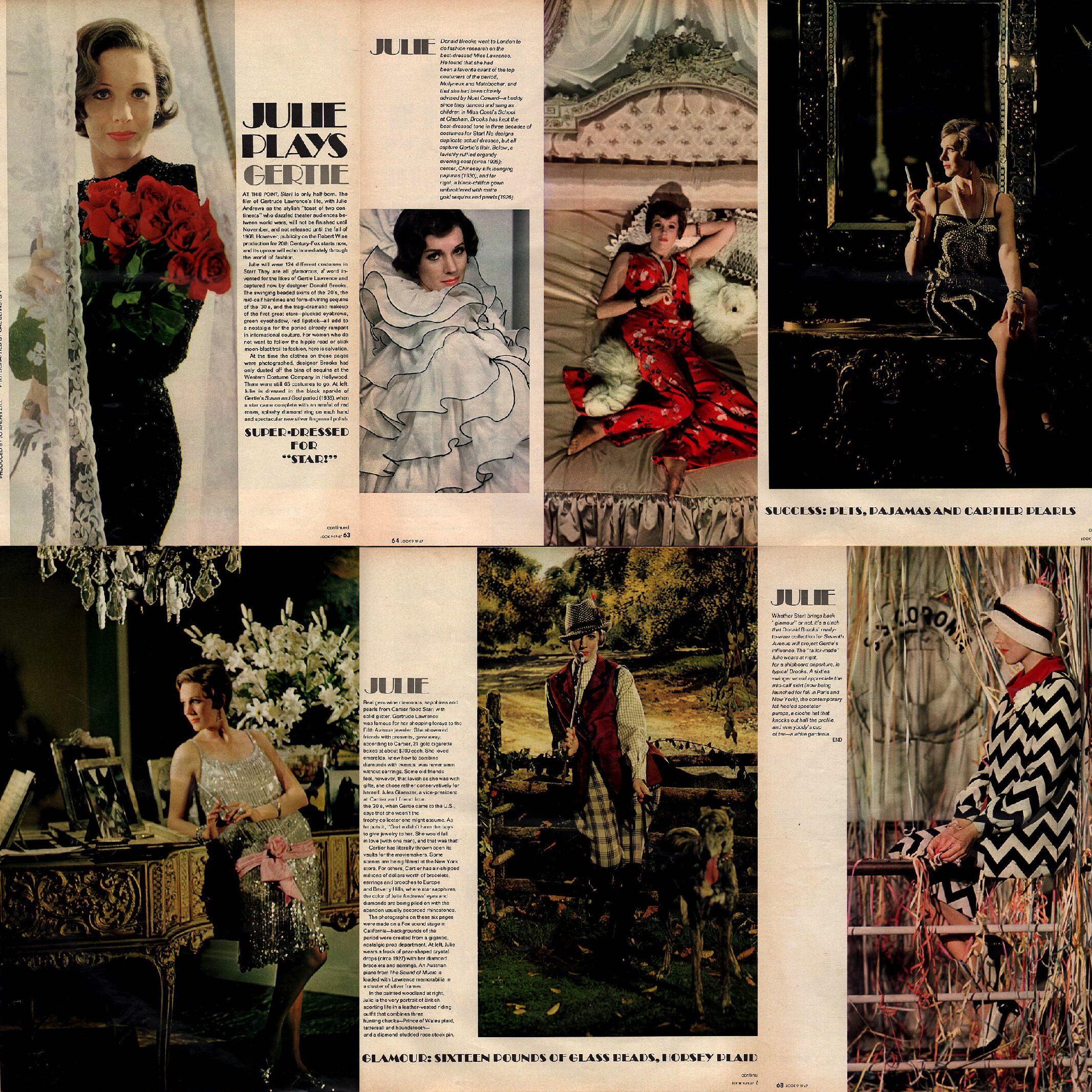
EL GLAMOUR DE GERTIE
Star! fue uno de los últimos grandes musicales de estudio, un género costoso que estaba pasando de moda rápidamente, cuando "los años sesenta" se extendieron por Hollywood. Aprovechando la ola de la contracultura y las nuevas tecnologías que abarataron la producción, una nueva generación de cineastas se liberó de la tiranía del escenario sonoro.
La segunda colaboración entre Julie Andrews y Robert Wise, tras el gran éxito de The Sound of Music, Star! retrató el glamour y la opulencia de la vida y la carrera de Gertrude Lawrence. El título se inspiró en la "calidad de estrella" que el amigo cercano y colaborador de Lawrence, Noel Coward, atribuyó a la actriz y que convirtió a "Gertie" en la pantalla y el escenario, así como en la consentida de la sociedad de la época. En su propia biografía, A Star Danced, Lawrence recuerda su camino al estrellato predicho por una máquina de adivinación
En el muelle, entre otras máquinas tragamonedas de un centavo, había una que mostraba una imagen llamativamente pintada de un gitano. La máquina prometió adivinar tu fortuna por un centavo. Dejé caer mi pieza de cobre en la ranura y esperé ansiosamente mientras la máquina tocaba algunos compases de una melodía popular; luego procedió a clavarme una lengua de cartón rosa. Había palabras impresas en él. Arranqué el recibo y leí el destino de mi centavo:
una estrella bailaba,
Y naciste.
Acepté mi destino sin dudarlo. La gitana quiso decirme que yo sería bailarina y algún día sería una estrella.
Coward escribió Vidas privadas con Lorenzo en mente. La producción, en la que actuó junto al dramaturgo, se estrenó en el Phoenix Theatre de Londres en septiembre de 1930, marcando la pauta que caracteriza modales durante una década o más: sofisticación, ingenio frágil y elegancia. El mayor triunfo de Lawrence fue quizás como Liza Elliot en el musical de Moss Hart-Kurt Weill. Lady in the Dark (1941). A lo largo de su carrera, su canto y baile complementaron su presencia escénica excepcionalmente convincente; ella siguió siendo durante un cuarto de siglo una de las estrellas más populares en los escenarios estadounidenses y británicos en gran parte debido a eso. Pasó los años posteriores a su matrimonio en 1940 con Richard Aldrich, un productor estadounidense, en la United States. En marzo de 1951 abrió en Rodgers and Hammerstein's The King and I en Broadway, durante la ejecución de la cual ella murió.
Concebido para reflejar la época y el estilo lujoso de Lawrence, Star! rompió un récord con la cantidad de cambios de atuendo que Julie Andrews tuvo que ejecutar. Junto a Andrews como Lawrence, Daniel Massey interpretó a Noel Coward, quien era su padrino en la vida real.
La película se estrenó en 1968 en el Dominion Theatre, reemplazando The Sound of Music, which had run there for the previous three years. The Duke and Duchess of Kent attended the screening, which was promoted as a roadshow theatrical release and included a film program similar to a playbill. Ms. Andrews has generously supplied us with her copy of the program and an edition of Look, the magazine that promoted the film with a piece on her prior to the premiere. The below are rare scans from these publications:
Her biography in the program reads:
When Julie Andrews stepped up before the assembled array of filmdom’s glittering personalities to accept the Oscar for her performance in “Mary Poppins,” and then followed this achievement with a smashing personal triumph in Robert Wise’s “The Sound of Music,” Hollywood and the world press commented on her amazing and meteoric rise to fame in such a brief span of years. Nothing could be further from the truth! By the time Miss Andrews was recognized by her peers and by millions of fans all over the world, she was well-prepared for stardom by twenty years of hard work, study and professional experience. Julie was born in a little town called Walton-on-Thames, about twenty miles from London. Her parents were divorced when she was very young and her mother remarried an entertainer, Ted Andrews, whose name Julie adopted. Andrews was a musician and a singer and Julie’s mother was an accomplished pianist; together they worked up an act for vaudeville. Traveling around the music halls of the British provinces gave Julie her first taste of show business.
At the age of 12 she astounded the audience at the London Hippodrome in the “Starlight Roof” Revue with an operatic solo in a clear and crystal voice which assured her a future in the theatre. By 1952 she was one of the most successful and highly paid actresses in England, and Vida Hope sought her out to play the lead in “The Boy Friend,” the London hit which she was planning to send to Broadway. Julie accepted with considerable reluctance, not relishing a long contractual exile in an alien land.
But New York hailed the young star in the musical spoof and took her to its collective heart and kept the show running for a year. She had proved herself adept in the frothy, campy, musical pastiche, but the big trial still lay ahead. It came when Alan Jay Lerner called her to audition for the difficult role of Eliza Doolittle in “My Fair Lady.” the musical version of Shaw’s “Pygmalion.” It was a most demanding role, requiring real acting ability, an impish cockney humor, and a graceful elegance all wrapped up in a musical score that embraced more than a half dozen difficult numbers. Results: “My Fair Lady” made Broadway history and Julie Andrews’ stardom was assured.
After a 2 year run on Broadway, Miss Andrews returned to London to play the role for eighteen months and then came back to Broadway to roll up 873 performances in “Camelot.”
Walt Disney then stepped into the picture and offered her the starring role with Dick Van Dyke in “Mary Poppins” which won her an Academy Award. ”The Americanization of Emily’ followed. Robert Wise then tapped her for “The Sound of Music” which was to become the greatest smash in the entire history of the screen. Since then she was co-starred with Max Von Sydow in “Hawaii,” “Torn Curtain” with Paul Newman and “Thoroughly Modern Millie.” She is probably the only star who never made a film which did not make a profit.
As one journalist put it, “The lady is more than a great star, she is a whole whirling dazzling constellation. Julie is not just an ordinary movie personality, she is a phenomenon.”
